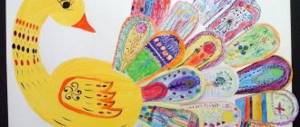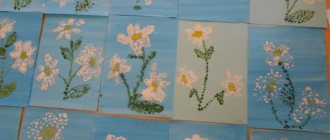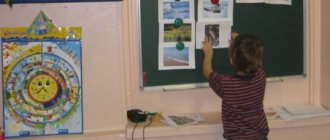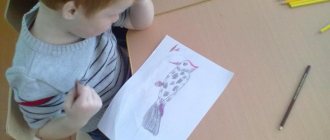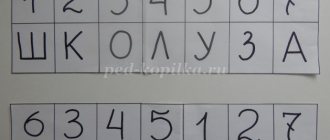LiveInternetLiveInternet
Quote from the message EVERYTHING_for_PRESCHOOL CHILDREN
Read in full In your quotation book or community!
GOLDEN KHOKHLOMA - part 1. Material for classes 1-5
| GOLDEN KHOKHLOMA Read to children about the original phenomenon of Russian folk arts and crafts - Golden Khokhloma. |
Golden Khokhloma is a bright, original phenomenon of Russian folk arts and crafts. This traditional art craft has a history of more than three hundred years. It arose in the 17th century in the Nizhny Novgorod Trans-Volga region near the trading village of Khokhloma.
In this remote forest region, very favorable conditions have historically developed for the development of folk arts and crafts. The entire territory of the region was like one workshop scattered across hundreds of villages, where the residents, as if by agreement, divided the entire technological process among themselves. Village residents engaged in individual labor operations settled nearby, forming their own “workshop” or “bush.” Each group of villages had a center - a large trading village, where peasants came every week to the market to sell their products. The villages where wooden utensils were sharpened and painted were grouped around the large trading village of Khokhloma, which gave its name to the entire art of painting.
Wooden utensils have been common in Rus' since ancient times: a wooden spoon or bowl could be seen on the table of a noblewoman and in a peasant’s hut, in the household of a rich patrimonial landowner and in royal use. Decorative wooden dishes were painted in bright, rich colors and painted with different paints, sometimes with gold and silver. A beautifully decorated spoon or ladle was considered a gift. But even the simplest dishes could not be used unpainted: hot food weakened the wood and cracks formed in it. Therefore, unpainted dishes were covered with drying oil - boiled linseed oil.
Painted, and even with gold, dishes were inaccessible to the peasant. However, folk craftsmen were able to make dishes no worse than the gold boyars, but peasants could also use them. This is how dishes with Khokhloma painting appeared - dishes that can easily withstand hot weather, are not afraid, according to the masters, of either heat or cold, wash well, serve for a long time, but the elegance rivals gold, and is affordable for the poor.
The origin of the techniques for painting wooden utensils golden without the use of gold remains a mystery even to specialists today. The original technology, proven over centuries, is the magical process that turns ordinary white wood into a shiny gold product.
The process of making Khokhloma dishes is not at all simple. First, the product was hammered out of raw wood. White dishes (“linen”) were kept at room temperature for 12-15 days to dry. Then it was primed and coated with clay. The fact is that wood is a very porous material, and in order to close all the pores and create a waterproof layer, it had to be coated. Ordinary clay turned out to be a good material for this. The craftsmen called this clay vap, which is why the process of impregnating products with clay began to be called vapening. The clay was dissolved in warm water, the pieces were kneaded, mixed, obtaining a solution of a certain thickness. Then they lubricated the walls of the product with a thick layer and left it for a while - the solution should have been absorbed. Then they lubricated it again. The product, which had been vaporized in this way, with a clay crust formed on it, was placed on boards where it was supposed to dry.
The dried product was soaked in uncooked linseed oil and again left for a short time so that the clay layer mixed with the oil. Then the product was polished, wiping the surface with bast wool and linen rags. After polishing, the product was placed on boards in a heated oven and kept there for 4-5 hours.
The next operation is putty, that is, putting the product with clay mixed with drying oil. This mixture was supposed to seal all the irregularities, knots, cracks and other wood defects. The puttied product was again placed to dry.
This was followed by treatment with drying oil to create an oil film on the product. The products were coated with drying oil three times, each time they were dried again in between and only then they were placed in the oven at a temperature of 80-90 degrees. The product thus tinned was tinned - coated with tin (aluminum) powder, and it became “silver”. Only after this the product was ready for painting. The painted tinned product was again generously coated with drying oil and placed on boards in a low-heat oven. And only then did the “silver” products magically turn into “gold”, finally acquiring such a familiar look to everyone.
| METHODOLOGICAL RECOMMENDATIONS FOR THE SECTION “KHOKHLOMA” This section introduces children to the basics of folk and decorative arts. |
| The series is intended for group and individual lessons with children of senior preschool and primary school age in labor and fine arts lessons. The basic techniques of Khokhloma painting are presented. The material is presented according to the principle from simple to complex, from studying the basic elements of Khokhloma painting and repetition exercises to tasks for improvisation and painting three-dimensional images. The materials can be successfully used by teachers, teachers of senior groups of preschool educational institutions, teachers of art schools, heads of clubs and various studios, as well as parents in home lessons with children. To get started you need to have: • gouache paints of yellow, red, green and black colors; • squirrel brushes No. 2 and No. 3; • a jar of water; • a soft cloth to remove excess paint from the brush; • a piece of white thick paper or a small white plate without patterns, which will serve as a palette. |
| LESSON 1. “GRASS” PATTERN We learn to draw the simplest elements of a grass pattern. Children perform exercises to repeat the main distinctive elements of the “grass” pattern. |
In Khokhloma painting, “grass” is an ornament made with separate rhythmically arranged strokes.
All elements of the herbal ornament are drawn immediately with a brush, without applying a preliminary drawing with a pencil, and the brush must be held with three fingers perpendicular to the surface of the sheet. The exercise includes the main elements of “grass”:
“Sedges” are the simplest element of the pattern; it is performed by lightly moving the tip of the brush from top to bottom;
“Blanks of grass” are strokes with a slight smooth thickening;
“Droplets” are drawn by applying the brush to the paper;
“Whiskers” are drawn as a continuous line of equal thickness, twisted into a spiral.
“Curls” are performed with light pressure in the middle of the element;
“Bush” is the most complex element of “grass”; it consists of simpler symmetrically arranged elements - “sedges”, “blades of grass”, “droplets”, “tendrils” and “curls”.
| LESSON 2. “Gift for Mishutka” Children are invited to independently invent and decorate a spoon with elements of a herbal ornament, using two colors - black and red. |
In all improvisation tasks, children first look at the painting done by the master, and then independently paint the design of the product.
With your children, look at a cup with a grass pattern made by a master. The festive and solemn color of the painting is achieved by a combination of gold, red and black colors.
Children are invited to independently invent and decorate a spoon with elements of a herbal ornament, using two colors - black and red.
LESSON 3. HERBAL ORNAMENT
The goal of the lesson is to gradually, using a method from simple to complex, teach children to draw a complex herbal pattern, using all previously studied elements.
First, children practice pointing the leading stem of the “criul.” The main element of the “criul” is the “curl”; it has the same length and twists alternately up and down. The pattern is then complicated by adding red and black “bushes”.
ACTIVITY 4. PAINTING A CUP
Children decorate a cup with a herbal ornament, drawing the leading stem themselves and using previously studied elements of the herbal ornament.
When examining a salt shaker with a grass pattern, we draw the children’s attention to the rhythmic alternation of ornamental elements. The smooth flow of the leading line - “kriulya” - emphasizes the rounded shape of the product, red and black colors give the painting a solemn and festive sound.
| LESSON 5. Pattern “Leaves” In the Khokhloma “leaf” pattern, in addition to red and black, green and yellow are also used. |
Series of messages “- folk crafts”:
Part 1 - Gorodets painting. Part 2 - Mezen painting. ... Part 7 - Album. Gorodets painting Part 8 - Templates for painting Part 9 - GOLDEN KHOKHLOMA - part 1. Material for classes 1-5 Part 10 - GOLDEN KHOKHLOMA - PART 2. MATERIAL FOR CLASSES 6-11
Notes on the application "Khokhloma"
Topic of the week:
Berries.
Application:
Branch with berries (Khokhloma painting).
Program content:
decorating spoons with floral patterns based on Khokhloma painting.
learn to cut leaves and berries along the contour with scissors; learn to draw curls, grass, veins;
introduce children to the works of Khokhloma masters;
to cultivate accuracy in work, perseverance, and the desire to complete the work started;
develop creativity and imagination when decorating spoons. Materials:
Colored paper, scissors, glue stick, markers, wooden spoons.
Work progress:
1 hour.
Organizational work.
In the old days, in a village called Khokhloma, craftsmen made wooden spoons from birch, aspen, and alder. They turned the spoons from special blanks, then soaked them in linseed oil, dried them, and then painted and varnished them. Russian spoons are famous all over the world. Take your time to look at the carved spoons and ladles. There the grass curls and flowers of unprecedented beauty. They shine like gold, as if bathed in the sun. All the leaves are like leaves, but here every one is golden. People call this kind of beauty Khokhloma. 2h.
Show sample.
We start by cutting out the templates. We transfer the templates onto colored paper: yellow base, green leaves, red berries. Cut it out. Glue on the large leaves. Glue on red strawberries. Glue on a small leaf. Glue red currant berries. Using a black felt-tip pen, we draw dots on the strawberries. We draw veins on the leaves with a dark green felt-tip pen. Draw green swirls on the spoon. On the handle of the spoon, paint the base and tip with red. Use a black felt-tip pen to outline all the elements of the pattern for brightness. Our work is ready. This is how the spoon looks on a white background. 3h.
Independent work.
Remind the sequence of work and ensure that it is completed correctly.
Remind the rules for working with scissors: - do not play with scissors, they are not a toy; - do not run your fingers over the blades of the scissors, they can cut you off; — you cannot place scissors on the edge of the table, they can fall and hurt you; — scissors cannot be passed with the tip outward; - you can’t swing scissors; - you need to close the scissors if you are not cutting anything else with them. Khokhloma painting - a scattering of scarlet berries. Echoes of summer in the gold of the grass. Groves, copses, silky splashes of Sunny-honey golden foliage. Khokhloma painting is like a witchcraft, It asks itself to be a fairy-tale song. And nowhere in the world are there such inflorescences, Our Khokhloma is the most wonderful of all. Thank you for your attention!

